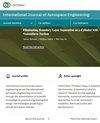注意力分配水平的实时测量模型及其在模拟 SPO 任务中的应用
IF 1.2
4区 工程技术
Q3 ENGINEERING, AEROSPACE
引用次数: 0
摘要
大多数人为飞行事故都可归咎于飞行员的注意力不足和监控失误。因此,飞行员的注意力分配与他们的任务表现密切相关。本研究旨在分析飞行员的固定特征和注意力分配水平。首先,我们提出了一个基于显著性、努力、期望和价值(SEEV)模型的注意分配水平测量模型。其次,我们构建了一个低仿真的单人驾驶(SPO)驾驶舱环境,并招募了 20 名飞行员进行实验,以比较他们在单人驾驶和双人驾驶(DPO)场景下的注视特征。结果表明,在单引擎故障场景下,SPO 和 DPO 飞行员分配的注意力水平略有不同。研究认为,以人为本的飞行甲板设计可以提高飞行员的注意力分配水平。这些发现可用于优化未来的飞行甲板设计和飞行训练,以提高飞行员的任务绩效。本文章由计算机程序翻译,如有差异,请以英文原文为准。
A Real-Time Measurement Model of Attention-Allocation Level and Its Application in Simulated SPO Task
Most human-caused flight accidents can be attributed to a pilot’s attention deficit and monitoring errors. Accordingly, pilots’ attention allocation is strongly related to their task performance. This study is aimed at analyzing pilots’ fixation characteristics and attention-allocation levels. First, we proposed a model for measuring attention-allocation level based on the salience, effort, expectancy, and value (SEEV) model. Second, a low-fidelity single-pilot operation (SPO) cockpit environment was constructed, and 20 pilots were recruited for an experiment to compare their fixation characteristics between SPO and double-pilot operation (DPO) scenarios. The results showed slight differences in the attention levels allocated by SPO and DPO pilots under a scenario of one-engine failure. It concluded that Human-centered flight deck design can enhance a pilot’s attention allocation level. These findings can be used to optimize future flight deck designing and flight training for improving pilot’s task performance.
求助全文
通过发布文献求助,成功后即可免费获取论文全文。
去求助
来源期刊

International Journal of Aerospace Engineering
ENGINEERING, AEROSPACE-
CiteScore
2.70
自引率
7.10%
发文量
195
审稿时长
22 weeks
期刊介绍:
International Journal of Aerospace Engineering aims to serve the international aerospace engineering community through dissemination of scientific knowledge on practical engineering and design methodologies pertaining to aircraft and space vehicles.
Original unpublished manuscripts are solicited on all areas of aerospace engineering including but not limited to:
-Mechanics of materials and structures-
Aerodynamics and fluid mechanics-
Dynamics and control-
Aeroacoustics-
Aeroelasticity-
Propulsion and combustion-
Avionics and systems-
Flight simulation and mechanics-
Unmanned air vehicles (UAVs).
Review articles on any of the above topics are also welcome.
 求助内容:
求助内容: 应助结果提醒方式:
应助结果提醒方式:


